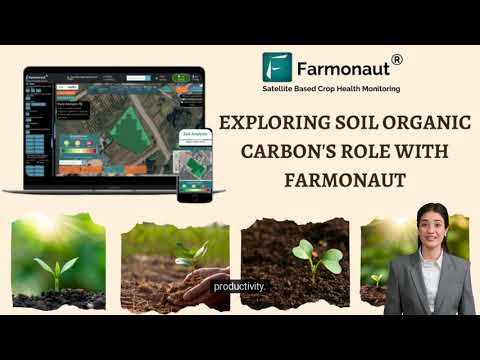Maximizing Crop Profitability: Innovative Strategies for Illinois Farmers in 2024 and Beyond
“The 4R nutrient stewardship principles can increase crop yield efficiency by up to 30% while reducing environmental impact.”
As we step into 2024 and beyond, the agricultural landscape in Illinois is evolving at an unprecedented pace. We find ourselves at the crossroads of tradition and innovation, where crop profitability strategies are being redefined by cutting-edge technologies and sustainable practices. In this comprehensive guide, we’ll explore how Illinois farmers can navigate these changes to maximize their yields and secure a prosperous future.
The Changing Face of Illinois Agriculture
Illinois has long been synonymous with bountiful harvests and sprawling fields of corn and soybeans. However, the challenges of unpredictable weather patterns, fluctuating markets, and increasing environmental concerns are pushing us to adopt more innovative approaches to farming. As we look towards the future, it’s clear that success will hinge on our ability to embrace new technologies and sustainable practices while maintaining the rich agricultural heritage of our state.

Embracing the 4R Principles for Nutrient Stewardship
At the heart of modern crop management lies the concept of nutrient stewardship. The 4R principles—Right Source, Right Rate, Right Time, and Right Place—form the cornerstone of efficient and environmentally responsible nutrient management. Let’s break down how Illinois farmers can implement these principles to boost their crop profitability:
- Right Source: Choosing fertilizers that match crop needs and soil conditions
- Right Rate: Applying the optimal amount of nutrients to meet crop requirements without excess
- Right Time: Timing nutrient applications to coincide with crop uptake patterns
- Right Place: Placing nutrients where crops can access them most efficiently
By adhering to these principles, we not only optimize nutrient use efficiency but also minimize environmental impact, creating a win-win situation for both farmers and the ecosystem.
Precision Agriculture: The Game-Changer for Illinois Farms
“Implementing precision agriculture techniques can lead to a 15-20% reduction in input costs for Illinois farmers.”
Precision agriculture is revolutionizing the way we approach farming in Illinois. By leveraging advanced technologies, we can make data-driven decisions that lead to increased yields and reduced costs. Here’s how precision agriculture is shaping the future of farming in our state:
- Satellite Imagery: Real-time crop health monitoring allows for timely interventions
- GPS-Guided Equipment: Ensures precise application of inputs, reducing waste and improving efficiency
- Soil Sensors: Provide detailed information on soil moisture and nutrient levels
- Drones: Offer aerial views for crop scouting and identifying problem areas
One of the leading innovators in this space is Farmonaut, offering advanced satellite-based farm management solutions. Their platform provides valuable services such as real-time crop health monitoring and AI-based advisory systems, making precision agriculture accessible to farmers of all scales.
Sustainable Farming Practices: A Path to Long-Term Profitability
Sustainability is no longer just a buzzword—it’s a critical component of long-term profitability in agriculture. As Illinois farmers, we must adopt practices that not only boost yields but also preserve our precious soil and water resources. Here are some sustainable farming practices that are gaining traction:
- Cover Cropping: Improves soil health and reduces erosion
- Crop Rotation: Enhances soil fertility and breaks pest cycles
- Conservation Tillage: Minimizes soil disturbance and retains moisture
- Integrated Pest Management: Reduces reliance on chemical pesticides
These practices not only contribute to environmental stewardship but also lead to improved soil health, which in turn supports higher yields and reduced input costs over time.
Optimizing Grain Storage and Drying: Maximizing Post-Harvest Profits
A crucial aspect of crop profitability often overlooked is post-harvest management. Efficient grain storage and drying techniques can significantly impact a farmer’s bottom line. Here’s how Illinois farmers can optimize their post-harvest operations:
- Invest in Modern Storage Facilities: Temperature-controlled bins reduce spoilage and maintain grain quality
- Implement Proper Drying Techniques: Use energy-efficient dryers to achieve optimal moisture levels
- Monitor Grain Condition: Regular checks prevent quality degradation and potential losses
- Consider On-Farm Storage: Allows for strategic selling when market prices are favorable
By mastering these aspects of grain management, we can ensure that our hard work in the fields translates into maximum profits at the point of sale.
Navigating Volatile Markets: Strategies for Financial Stability
The agricultural market can be unpredictable, but with the right strategies, Illinois farmers can mitigate risks and maintain financial stability. Here are some approaches to consider:
- Diversification: Growing a variety of crops can spread risk and take advantage of different market opportunities
- Futures Contracts: Locking in prices for a portion of your crop can provide financial security
- Value-Added Products: Processing crops into higher-value products can increase profit margins
- Direct Marketing: Selling directly to consumers or local businesses can command higher prices
Additionally, staying informed about market trends and using tools like Farmonaut’s platform for real-time data can help in making informed decisions about when to sell and at what price.
Leveraging Advanced Plant Nutrition Strategies
As our understanding of plant biology deepens, so does our ability to fine-tune nutrition strategies for optimal crop performance. Here are some advanced approaches Illinois farmers should consider:
- Foliar Feeding: Direct application of nutrients to leaves for rapid uptake
- Biostimulants: Natural substances that enhance nutrient uptake and stress tolerance
- Precision Nutrient Timing: Applying nutrients at critical growth stages for maximum effect
- Micronutrient Management: Addressing deficiencies in trace elements for balanced crop nutrition
These strategies, when combined with the 4R principles, can lead to significant improvements in crop health and yield potential.

Harnessing the Power of Data for Decision-Making
In today’s digital age, data is king. The ability to collect, analyze, and act on farm data can be a game-changer for Illinois farmers. Here’s how we can leverage data to drive profitability:
- Farm Management Software: Centralizes data for easy analysis and decision-making
- Weather Analytics: Helps in planning planting and harvesting activities
- Yield Mapping: Identifies high and low-performing areas of fields for targeted management
- Predictive Analytics: Forecasts potential issues before they become major problems
Farmonaut’s platform excels in this area, offering farmers access to satellite imagery and AI-driven insights that can inform crucial farming decisions.
Adapting to Changing Environmental Conditions
Climate change presents both challenges and opportunities for Illinois farmers. Adapting to these changes is crucial for maintaining and improving crop profitability. Consider these strategies:
- Drought-Resistant Crops: Selecting varieties that can withstand periods of low rainfall
- Water Management: Implementing efficient irrigation systems and water conservation practices
- Soil Health Improvement: Building organic matter to increase water retention capacity
- Adaptive Planting Dates: Adjusting planting schedules based on changing weather patterns
By staying flexible and proactive in our approach to environmental changes, we can turn potential threats into opportunities for growth and innovation.
Innovative Strategies for Maximizing Crop Profitability in Illinois (2024)
| Strategy | Implementation Cost | Potential Yield Increase | Environmental Impact | Technology Requirements |
|---|---|---|---|---|
| 4R Nutrient Management | Medium | 15-30% | Positive | Intermediate |
| Precision Agriculture Tools | High | 10-20% | Positive | Advanced |
| Efficient Grain Storage and Drying | Medium | 5-10% | Neutral | Basic |
| Sustainable Farming Practices | Low | 10-25% | Positive | Basic |
| Advanced Plant Nutrition Strategies | Medium | 15-25% | Positive | Intermediate |
The Role of Technology in Modern Farm Equipment
The evolution of farm equipment is playing a crucial role in improving efficiency and profitability. Here’s how technology is transforming our machinery:
- Smart Tractors: Equipped with GPS and auto-steering for precise field operations
- Variable Rate Technology: Allows for customized application of inputs across fields
- Telematics: Provides real-time data on equipment performance and location
- Automated Systems: Reduces labor costs and increases operational efficiency
These advancements in farm equipment technology are not just improving efficiency; they’re also contributing to more sustainable farming practices by reducing waste and optimizing resource use.
Financial Planning and Risk Management
Effective financial planning is crucial for long-term success in farming. Here are some key aspects to consider:
- Budgeting: Developing detailed budgets for each crop and operation
- Cash Flow Management: Ensuring adequate liquidity to cover operational expenses
- Insurance: Utilizing crop insurance to protect against unforeseen losses
- Diversification: Exploring alternative income streams to spread risk
By taking a proactive approach to financial management, Illinois farmers can build resilience against market volatility and weather uncertainties.
Embracing Blockchain for Supply Chain Transparency
Blockchain technology is set to revolutionize the agricultural supply chain, offering unprecedented levels of transparency and traceability. Here’s how it can benefit Illinois farmers:
- Product Traceability: Allows consumers to track the journey of their food from farm to table
- Fair Pricing: Eliminates middlemen, potentially leading to better prices for farmers
- Quality Assurance: Helps maintain the integrity of organic and specialty crops
- Efficient Payments: Enables faster, more secure transactions within the supply chain
Farmonaut’s blockchain-based traceability solutions are at the forefront of this technology, offering farmers a way to differentiate their products and build consumer trust.
Collaboration and Knowledge Sharing
In the rapidly evolving world of agriculture, staying informed and connected is more important than ever. Here are some ways Illinois farmers can benefit from collaboration:
- Farmer Networks: Joining local and online communities to share experiences and best practices
- Research Partnerships: Collaborating with universities and research institutions for field trials
- Cooperative Initiatives: Pooling resources for shared equipment or bulk purchasing
- Mentorship Programs: Connecting experienced farmers with newcomers to the industry
By fostering a culture of collaboration, we can accelerate innovation and ensure that the benefits of new technologies and practices are widely shared across our farming community.
Conclusion: Charting a Course for a Prosperous Future
As we look towards 2024 and beyond, the path to maximizing crop profitability for Illinois farmers is clear. It involves embracing innovative technologies, adopting sustainable practices, and staying agile in the face of changing market and environmental conditions. By implementing the strategies outlined in this guide—from precision agriculture and nutrient stewardship to advanced financial planning and supply chain innovation—we can ensure that Illinois remains at the forefront of agricultural excellence.
The future of farming is bright, and with tools like Farmonaut’s satellite-based farm management solutions, we have the power to make data-driven decisions that will propel our farms to new heights of productivity and profitability. Let’s embrace these innovations and work together to build a sustainable and prosperous future for Illinois agriculture.
Frequently Asked Questions
Q: How can Illinois farmers start implementing precision agriculture techniques?
A: Start by investing in basic GPS technology for your equipment and exploring satellite imagery services like Farmonaut. Gradually incorporate soil sensors and variable rate technology as you become more comfortable with the systems.
Q: What are the most cost-effective sustainable farming practices for small-scale farmers?
A: Cover cropping and crop rotation are excellent starting points. These practices require minimal investment and can significantly improve soil health and reduce input costs over time.
Q: How can farmers best prepare for market volatility in the coming years?
A: Diversify your crop portfolio, consider futures contracts for a portion of your harvest, and stay informed about market trends. Utilizing farm management software can also help in making data-driven decisions.
Q: What role does soil health play in maximizing crop profitability?
A: Healthy soil is fundamental to high yields and resilient crops. Focus on building organic matter through practices like no-till farming and cover cropping. This improves water retention, nutrient availability, and overall soil structure.
Q: How can technology help in managing farm finances more effectively?
A: Farm management software can help track expenses, forecast revenues, and analyze profitability by field or crop. Additionally, platforms like Farmonaut provide valuable data for making informed decisions about resource allocation and timing of operations.
For more information on how Farmonaut can help you implement these strategies and maximize your crop profitability, visit our web app, download our Android app or iOS app, or explore our API for custom integrations. You can also check out our API Developer Docs for detailed information on how to leverage our technology for your specific needs.




















